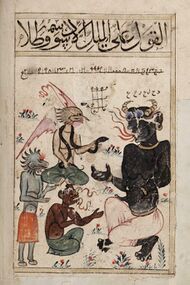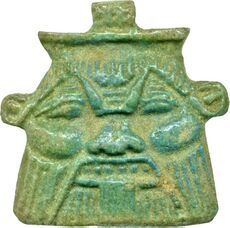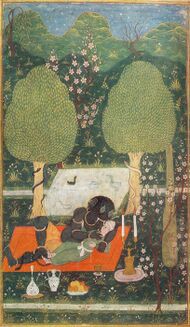Ifrit
Topic: Social
 From HandWiki - Reading time: 9 min
From HandWiki - Reading time: 9 min

| Part of a series on |
| Islam |
|---|
 |
|
|
Ifrit, also spelled as efreet and afrit (Arabic: ʻIfrīt: عفريت, pl ʻAfārīt: عفاريت), is a powerful type of demon in Islamic mythology. The afarit are often associated with the underworld and also identified with the spirits of the dead, and have been compared to evil geniī loci in European culture.[2] In Quran, hadith and Mi'raj narrations the term is always followed by the phrase among the jinn. In later folklore, they developed into independent entities, identified as powerful demons or spirits of the dead who sometimes inhabit desolate places such as ruins and temples. Their true habitat is the underworld.[3]
Etymology
The word ifrit derives from the Quran, but only as an epithet and not to designate a specific type of demon.[2][4] The term itself is not found in pre-Islamic Arabic poetry, although variants such as ifriya and ifr are recorded prior to the Quran.[4] Traditionally, Arab philologists trace the derivation of the word to عفر (ʻafara, "to rub with dust" or "to roll into dust").[3][5] It is further used to describe sly, malicious, wicked and cunning characteristics.[6] Some Western philologists suggest a foreign origin of the word and attribute it to Middle Persian afritan which corresponds to Modern Persian آفريدن (to create), but this is regarded as unlikely by others.[4] In folklore, the term developed into a designation of a specific class of demon, though most Islamic scholarly traditions regard the term as an adjective.[5][4] These popular beliefs were elaborated in works such as in Al-Ibshihi's (ar) Mustatraf. They became identified either as a dangerous kind of demon (shayatin) preying on women, or as spirits of the dead.[4]
Islamic scriptures

In Islamic scriptures the term ifrit is always followed by the expression of the jinn.[8] Due to the ambiguous meaning of the term jinn, which is applied to a wide range of different spirits, their relation towards the genus of jinn remains vague.[3] However within the Islamic scriptures themselves, the term is apparently used as an epithet to describe a powerful or malicious spirit of undefined nature.[9][4][3]
In the Quran itself, such an ifrit is mentioned in Sura An-Naml (27:38-40). The ifrit offers to carry the throne of Bilqis (the Queen of Sheba) to Solomon: "An ifrit from the jinn said: 'I will bring it to you before you rise from your place. And verily, I am indeed strong, and trustworthy for such work." However, the duty is not given to him, but to somebody who is endowed with knowledge of the scripture.[4] An "ifrit among the jinn" is mentioned in a hadith of Muhammad al-Bukhari, attempting to interrupt the prayers of the prophet Muhammed[10][lower-alpha 1] and in a narrative of Muhammad's night journey recorded in the 8th century by Malik ibn Anas. In the latter account, the "ifrit among the jinn" threatens Muhammad with a fiery presence, whereupon the archangel Gabriel taught Muhammad a Du'a (Islamic prayer) to defeat it.[12][8]
Islamic folklore
In Islamic folklore the afarit became a class of chthonic spirits, inhabiting the layers of the seven earths,[13][14] generally ruthless and wicked, formed out of smoke and fire.[lower-alpha 2] But despite their negative depictions and affiliation to the nether regions, afarit are not fundamentally evil on a moral plane; they might even carry out God's purpose. Such obligations can nevertheless be ruthless, such as obligation to blood vengeance and avenging murder.[3] An ifrit can further be bound to a sorcerer, if summoned.[8]
Egypt

Although afarit are not necessarily components of a person, but independent entities, a common belief in Islamic Egypt[lower-alpha 3] associates afarit with part of a human's soul.[20] Probably influenced by the Ancient Egypt idea of Ka, the afarit are often identified with the spirits of the dead, departing from the body at the moment of death. They live in cemeteries, wander around places the dead person frequently visited, or roam the earth close to the place of death, until the Day of Judgment. A person who died a natural death does not have a malevolent ifrit. Only people who are killed give rise to a dangerous and active ifrit, drawn to the blood of the victim. Driving an unused nail into the blood is supposed to stop their formation.[21] Such afarit might scare and even kill the living or take revenge on the murderer.[22][23] Martyrs, saints and prophets do not have a ghost, and therefore no ifrit.[23]
Morocco
In Moroccan belief, the afarit form a more powerful type of demon, compared to the jinn and other supernatural creatures. They have more substantial existence, and are greater in scale and capacity[24] than other demons.[25] Their physical appearance is often portrayed as having monstrous deformities, such as claw-like or thorny hands, flaming eyes or seven heads.[25][8]
Just as with jinn, an ifrit might possess an individual. Such persons gain some abilities from the ifrit, such as getting stronger and more brave, but the ifrit renders them insane.[24][25] With the aid of a magical ring, the afarit might be forced to perform certain orders, such as carrying heavy stones.[25]
Shabakism
A story circulates among the Shabak community in Northern Iraq about a certain ifrit who incensed Ali by his evil nature long before the creation of Adam. Consequently, for the ifrit's wickedness, Ali chained the ifrit and left him alone. When the prophets arrived, he appeared to all of them and begged them for his release, but no prophet was able to break the chains of the ifrit. When Muhammad found the ifrit, he brought him to Ali. Ali had mercy with the ifrit. He decided to release him under the condition that he surrender to the will of God.[26]
In fiction
Afarit appear already in early poems, such as those of Al-Maʿarri (973 – May 1057), who describes his protagonist visiting a paradise with "narrow straits" and "dark valleys" for afarit, between heaven and hell.[27] In later works, the afarait are mentioned among the narratives collected in One Thousand and One Nights. In one tale called "The Porter and the Young Girls", a prince is attacked by pirates and takes refuge with a woodcutter. The prince finds an underground chamber in the forest leading to a beautiful woman who has been kidnapped by an ifrit. The prince sleeps with the woman and both are attacked by the jealous ifrit, who changes the prince into an ape. Later a princess restores the prince and fights a pitched battle with the ifrit, who changes shape into various animals, fruit, and fire until being reduced to cinders.[28][3] In "The Fisherman and the Jinni" an ifrit, locked in a jar by the Seal of Solomon, is released but later tricked by the fisherman again into the jar. Under the condition that the ifrit aids him to achieve riches, he releases the ifrit again.[29] The latter ifrit however, might be substituted by a marid, another type of powerful demon[28][3] easily tricked by the protagonist.[30] The latter portrayal of an ifrit, as a wish-granting spirit released from a jar, became characteristic of Western depictions of jinn.[29]
In postmodernity, afarit featured frequently in film and video games. In the Final Fantasy video game series, an ifrit appears as a summonable spirit and an enemy. Like their mythological counterparts, they are spirits of fire and can use an iconic spell called hellfire.[31] In the fifth season of True Blood (2012), an ifrit seeks vengeance for murder of Iraqi civilians by U.S soldiers, giving space for consideration of US warcrimes in Iraq and Islamophobia.[32] In both the novel American Gods (2001) and the television adaptation by Neil Gaiman an ifrit disguised as a taxi-driver appears, trying to get used to his new role, seeking for intimacy in a lonely world.[33]
See also
Notes
- ↑ In Shibli's (d. 1367) retelling, he calls the ifrit a shaitan, underlining the ambiguous nature of the afarit.[11]
- ↑ This is contrary to the jinn in Quranic traditions, who are created out of clear fire,[3] but in line with a common tradition depicting the demons (shayāṭīn), as created out of smoke.[15]
- ↑ Although the identification of afarit with ghosts is usually associated with Muslims in Egypt, it is also attested by Muslims in India, Syria and among Javanese Muslims in Cirebon.[17][18][19]
References
- ↑ Sleigh, Tom (2018). The Land between Two Rivers: Writing in an Age of Refugees. Graywolf Press. pp. chapter: 1.11. ISBN 978-1-555-97986-7.
- ↑ 2.0 2.1 Edward Westermarck Ritual and Belief in Morocco: Vol. I (Routledge Revivals) Routledge, 23 Apr 2014 ISBN:9781317912682 p. 387
- ↑ 3.0 3.1 3.2 3.3 3.4 3.5 3.6 3.7 Chelhod, J., “ʿIfrīt”, in: Encyclopaedia of Islam, Second Edition, Edited by: P. Bearman, Th. Bianquis, C.E. Bosworth, E. van Donzel, W.P. Heinrichs. Consulted online on 06 October 2019 <http://dx.doi.org/10.1163/1573-3912_islam_SIM_3502> First published online: 2012 First print edition: ISBN:9789004161214, 1960-2007
- ↑ 4.0 4.1 4.2 4.3 4.4 4.5 4.6 McAuliffe, Jane Dammen. Encyclopaedia of the Qurʾān. 3. Georgetown University, Washington DC. pp. 486–487.
- ↑ 5.0 5.1 Chelhod, J., “ʿIfrīt”, in: Encyclopaedia of Islam, Second Edition, Edited by: P. Bearman, Th. Bianquis, C.E. Bosworth, E. van Donzel, W.P. Heinrichs. Consulted online on 26 September 2019 doi:10.1163/1573-3912_islam_SIM_3502 First published online: 2012 First print edition: ISBN:9789004161214, 1960-2007
- ↑ "الباحث العربي: قاموس عربي عربي". http://www.baheth.info/all.jsp?term=%D8%B9%D9%81%D8%B1%D9%8A%D8%AA.
- ↑ de Lafayette, Maximillien (2017). Early & contemporary spirit artists, psychic artists, and medium painters from 5000 BC to the present day economy. p. 95. ISBN 978-1-365-97802-9.
- ↑ 8.0 8.1 8.2 8.3 Szombathy, Zoltan, “ʿIfrīt”, in: Encyclopaedia of Islam, THREE, Edited by: Kate Fleet, Gudrun Krämer, Denis Matringe, John Nawas, Everett Rowson. Consulted online on 06 October 2019 <http://dx.doi.org/10.1163/1573-3912_ei3_COM_32379> First published online: 2018 First print edition: ISBN:9789004356641, 2018, 2018-3
- ↑ Vincent Crapanzano The Ḥamadsha: A Study in Moroccan Ethnopsychiatry University of California Press 1973 ISBN:9780520022416 p. 136
- ↑ Lebling, Robert (2010-07-30). Legends of the Fire Spirits: Jinn and Genies from Arabia to Zanzibar. I.B.Tauris. pp. 141, 151–153. ISBN 978-0-857-73063-3.
- ↑ Nünlist, Tobias (2015) (in German). Dämonenglaube im Islam. Walter de Gruyter GmbH & Co KG. pp. 109. ISBN 978-3-110-33168-4.
- ↑ Brooke Olson Vuckovic Heavenly Journeys, Earthly Concerns: The Legacy of the Mi'raj in the Formation of Islam Routledge, 2004 ISBN:9781135885243 p. 35-36
- ↑ Sebastian Günther, Dorothee Pielow Die Geheimnisse der oberen und der unteren Welt: Magie im Islam zwischen Glaube und Wissenschaft BRILL, 18 October 2018 ISBN:9789004387577 p. 597
- ↑ Stephan Conermann History and Society During the Mamluk Period (1250-1517) V&R unipress GmbH, 2014 ISBN:9783847102281 p. 25
- ↑ Hossein Nasr, Seyyed (2013). Islamic Life and Thought. Routledge. pp. 135. ISBN 978-1-134-53818-8.
- ↑ Hans Alexander Winkler Ghost Riders of Upper Egypt: A Study of Spirit Possession American Univ in Cairo Press, 2009 ISBN 9789774162503 p. 29
- ↑ Muhaimin, A.G. (2006). The Islamic Traditions of Cirebon: Ibadat and Adat among Javanese Muslims. ANU E Press. p. 38. ISBN 978-1-920942-31-1.
- ↑ Fartacek, Gebhard (2010) (in German). Unheil durch Dämonen?: Geschichten und Diskurse über das Wirken der Ǧinn ; eine sozialanthropologische Spurensuche in Syrien. Böhlau Verlag Wien. p. 68. ISBN 9783205784852.
- ↑ Frederick M. Smith The Self Possessed: Deity and Spirit Possession in South Asian Literature and Civilization Columbia University Press 2012 ISBN:978-0-231-51065-3 page 570
- ↑ el-Sayed El-Aswad Religion and Folk Cosmology: Scenarios of the Visible and Invisible in Rural Egypt Greenwood Publishing Group, 2002 ISBN:9780897899246 p. 103-104
- ↑ "Aeromancy". The Element Encyclopedia of the Psychic World. Harper Element. 2006. pp. 10.
- ↑ Lebling, Robert (2010). Legends of the Fire Spirits: Jinn and genies from Arabia to Zanzibar. I.B. Tauris. pp. 151–153. ISBN 978-0-85773-063-3.
- ↑ 23.0 23.1 el-Sayed El-Aswad Religion and Folk Cosmology: Scenarios of the Visible and Invisible in Rural Egypt Greenwood Publishing Group, 2002 ISBN:9780897899246 p. 153
- ↑ 24.0 24.1 Vincent Crapanzano The Ḥamadsha: A Study in Moroccan Ethnopsychiatry University of California Press 1973 ISBN:9780520022416 p. 137
- ↑ 25.0 25.1 25.2 25.3 Edward Westermarck Ritual and Belief in Morocco: Vol. I (Routledge Revivals) Routledge, 23 Apr 2014 ISBN:9781317912682 p. 263-264
- ↑ Matti Moosa Extremist Shiites: The Ghulat Sects Matti Moosa 1987 ISBN:978-0-815-62411-0 page 69
- ↑ Islam, Arabs, and Intelligent World of the Jinn Amira El-Zein 2009 ISBN:978-0-815-65070-6 page 20
- ↑ 28.0 28.1 Anne E. Duggan Ph.D., Donald Haase Ph.D., Helen J. Callow Folktales and Fairy Tales: Traditions and Texts from around the World, 2nd Edition [4 volumes]: Traditions and Texts from around the World ABC-CLIO, 12.02.2016 volume 2 ISBN:9781610692540 p. 402
- ↑ 29.0 29.1 Jeffrey Andrew Weinstock The Ashgate Encyclopedia of Literary and Cinematic Monsters Routledge, 01.04.2016 ISBN:9781317044253 p. 166-169
- ↑ Leon Hale (January 13, 2002). "Arabic mythology is worth revisiting". Houston Chronicle.
- ↑ Ruth Ayaß, Cornelia Gerhardt The Appropriation of Media in Everyday Life John Benjamins Publishing 2012 ISBN:9789027273376 p. 205
- ↑ Hudson, Dale. "'Of Course There Are Werewolves and Vampires': 'True Blood' and the Right to Rights for Other Species." American Quarterly, vol. 65, no. 3, 2013, pp. 661–687., www.jstor.org/stable/43822924.
- ↑ Tara Prescott Neil Gaiman in the 21st Century: Essays on the Novels, Children's Stories, Online Writings, Comics and Other Works McFarland, 11.02.2015 ISBN:9780786494774 p. 25
 KSF
KSF
